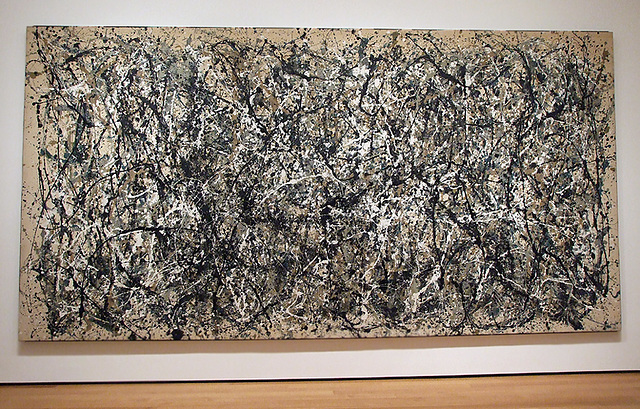One Number 31, 1950 by Jackson Pollock in the Muse…
Number 1, 1948 by Jackson Pollock in the Museum of…
Shimmering Substance by Jackson Pollock in the Mus…
Echo Number 25,1951 by Jackson Pollock in the Muse…
Echo Number 25,1951 by Jackson Pollock in the Muse…
Pasiphae by Jackson Pollock in the Metropolitan Mu…
No. 22 by Jackson Pollock in the Philadelphia Muse…
Stenographic Figure by Jackson Pollock in the Muse…
Location
Keywords
Authorizations, license
-
Visible by: Everyone -
All rights reserved
-
484 visits
One Number 31, 1950 by Jackson Pollock in the Museum of Modern Art, August 2007


Jackson Pollock. (American, 1912-1956). One: Number 31, 1950. 1950. Oil and enamel on unprimed canvas, 8' 10" x 17' 5 5/8" (269.5 x 530.8 cm). Sidney and Harriet Janis Collection Fund (by exchange).
Gallery label text
2006
This is one of three wall–size paintings that Pollock realized in swift succession in the summer and autumn of 1950. In 1947, Pollock began laying canvas on the floor and pouring, dribbling, and flicking enamel paint onto the surface, sometimes straight from the can, or with sticks and stiffened brushes. The density of interlacing liquid threads of paint is balanced and offset by puddles of muted colors and by allover spattering. The pictorial result of this tension is a landmark in the history of Abstract Expressionism.
Publication excerpt
The Museum of Modern Art, MoMA Highlights, New York: The Museum of Modern Art, revised 2004, originally published 1999, p. 194
One is a masterpiece of the "drip," or pouring, technique, the radical method that Pollock contributed to Abstract Expressionism. Moving around an expanse of canvas laid on the floor, Pollock would fling and pour ropes of paint across the surface. One is among the largest of his works that bear evidence of these dynamic gestures. The canvas pulses with energy: strings and skeins of enamel, some matte, some glossy, weave and run, an intricate web of tans, blues, and grays lashed through with black and white. The way the paint lies on the canvas can suggest speed and force, and the image as a whole is dense and lush—yet its details have a lacelike filigree, a delicacy, a lyricism.
The Surrealists' embrace of accident as a way to bypass the conscious mind sparked Pollock's experiments with the chance effects of gravity and momentum on falling paint. Yet although works like One have neither a single point of focus nor any obvious repetition or pattern, they sustain a sense of underlying order. This and the physicality of Pollock's method have led to comparisons of his process with choreography, as if the works were the traces of a dance. Some see in paintings like One the nervous intensity of the modern city, others the primal rhythms of nature.
Text from: www.moma.org/collection/browse_results.php?criteria=O:AD:...
Translate into English
Gallery label text
2006
This is one of three wall–size paintings that Pollock realized in swift succession in the summer and autumn of 1950. In 1947, Pollock began laying canvas on the floor and pouring, dribbling, and flicking enamel paint onto the surface, sometimes straight from the can, or with sticks and stiffened brushes. The density of interlacing liquid threads of paint is balanced and offset by puddles of muted colors and by allover spattering. The pictorial result of this tension is a landmark in the history of Abstract Expressionism.
Publication excerpt
The Museum of Modern Art, MoMA Highlights, New York: The Museum of Modern Art, revised 2004, originally published 1999, p. 194
One is a masterpiece of the "drip," or pouring, technique, the radical method that Pollock contributed to Abstract Expressionism. Moving around an expanse of canvas laid on the floor, Pollock would fling and pour ropes of paint across the surface. One is among the largest of his works that bear evidence of these dynamic gestures. The canvas pulses with energy: strings and skeins of enamel, some matte, some glossy, weave and run, an intricate web of tans, blues, and grays lashed through with black and white. The way the paint lies on the canvas can suggest speed and force, and the image as a whole is dense and lush—yet its details have a lacelike filigree, a delicacy, a lyricism.
The Surrealists' embrace of accident as a way to bypass the conscious mind sparked Pollock's experiments with the chance effects of gravity and momentum on falling paint. Yet although works like One have neither a single point of focus nor any obvious repetition or pattern, they sustain a sense of underlying order. This and the physicality of Pollock's method have led to comparisons of his process with choreography, as if the works were the traces of a dance. Some see in paintings like One the nervous intensity of the modern city, others the primal rhythms of nature.
Text from: www.moma.org/collection/browse_results.php?criteria=O:AD:...
- Keyboard shortcuts:
Jump to top
RSS feed- Latest comments - Subscribe to the comment feeds of this photo
- ipernity © 2007-2024
- Help & Contact
|
Club news
|
About ipernity
|
History |
ipernity Club & Prices |
Guide of good conduct
Donate | Group guidelines | Privacy policy | Terms of use | Statutes | In memoria -
Facebook
Twitter

Sign-in to write a comment.